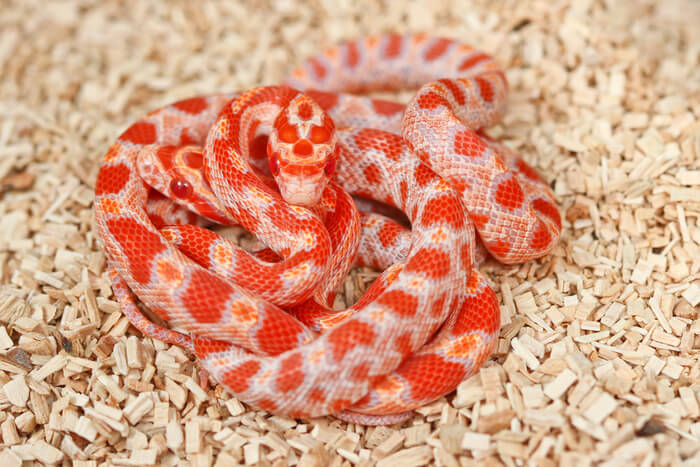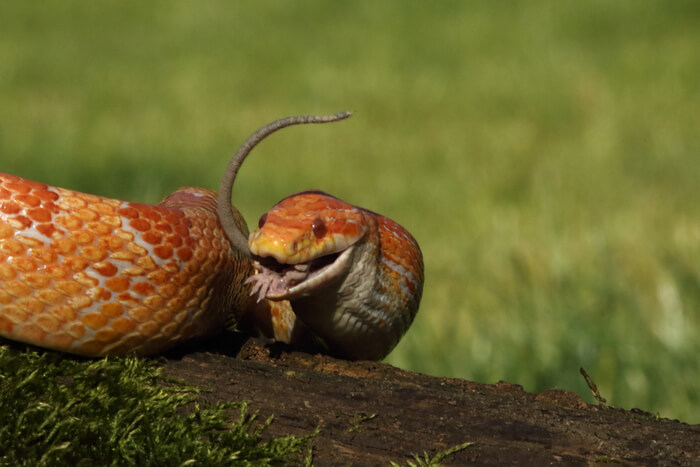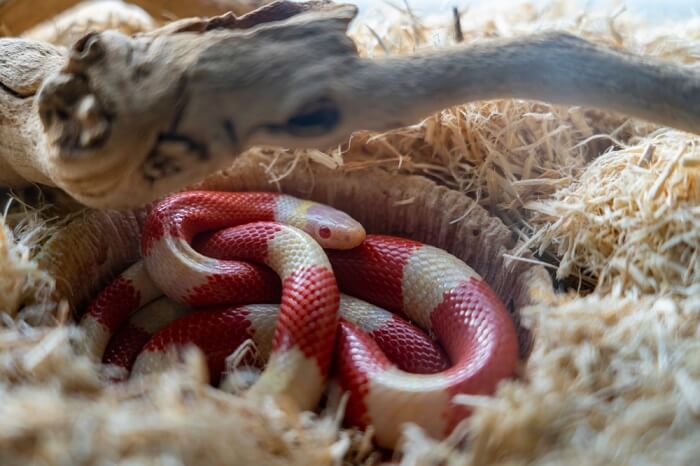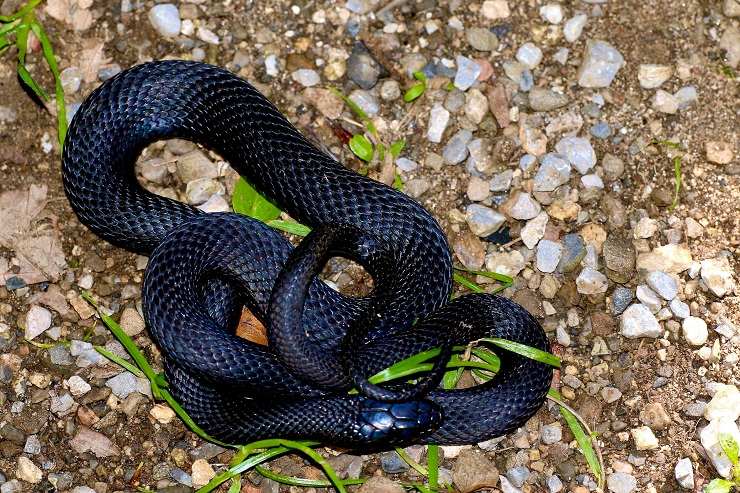Corn Snakes: Adult Size, Nutrition And Care Tips
This page contains affiliate links. We may earn money or products from the companies mentioned in this post through our independently chosen links, which earn us a commission. Learn More
Corn snakes are very popular pets. They have bright coloration, and their care is a low level of difficulty for reptiles. They’re also active and tolerate handling well. This article will help you understand their special needs and decide if they’re the right pet for you.
Care
Care of a reptile includes providing the right conditions for growth. A reptile needs the proper temperature, lighting, humidity, substrate and size. Corn snakes can live 15-20 years in captivity with good care.
Cage Size
Adult corn snakes can be up to 6 feet long. They are socially isolated animals and should be housed alone. For the long-term, snakes require a cage that allows them to fully extend their full body length in a straight line. Juveniles can be housed in a 10-gallon aquarium, but adults will need a cage that’s 4 to 6 feet long, depending on their adult size.
That’s also considered the minimum cage size and depends upon supervised exercise time outside the enclosure. If they don’t get a great deal of exercise time outside, then the cage should be even larger. The enclosure should have a secure lid or doors to prevent escape.
Enrichment time outside the enclosure helps keep their minds active, get important exercise and can be a fun bonding experience. Reptile enrichment is well described in a document from The American Association of Zoo Keepers that can be found here.
Substrate

Substrate in the enclosure needs to encourage natural behaviors. For the bottom of the cage, easy-to-clean substances are recommended. You can use reptile carpet as well as coconut fiber. Their native habitat is grassland and the outside edges of forest in the eastern US. They hide in rocks or hollow areas of trees, so hides are important to reduce stress.
Hides should be provided n both ends of the enclosure, so they don’t need to choose between hiding and finding the ideal temperature. Branches should be provided for climbing, since they will naturally climb low branches in the wild.
Temperature
Provide a temperature range between 70 and 85°F, with a basking area that stays around 90°F. Provide a powerful heat lamp or ceramic heater for your snake. Make sure that the lamp doesn’t allow direct contact. For good thermostat options please see our article on the best thermostats for reptiles.
Lighting
Provide a full-spectrum light source for 12 hours daily. Although there is no documented need for UVB in corn snakes, low-level UVB is beneficial. One study showed a three-fold increase in corn snakes with 28 days f low-level UVB exposure (Acierno MJ, Mitchell MA, Zachariah TT, et al: effects of ultraviolet radiation on plasma 25-hydroxyvitamin D3 concentrations in corn snakes (Elaphe juttata). Am J Vet Res 69:294-297, 2008.).
Humidity
Corn snakes need to have humidity between 30-50%. That means that most houses will be fine without a need for special humidifiers. Watch for any difficulty with shedding, as that indicates the humidity inside the enclosure is probably too low, which can happen due to the heat lamps. If the humidity is getting low, spraying water on the sides of the enclosure a few times a week may solve the problem.
If you live in a very dry region, then you may need a humidifier. See our related article for recommendations on choosing the best humidifier for your pet reptile.
Nutrition

Corn snakes are carnivores, feeding on rodents, lizards and bird eggs in the wild. In captivity, frozen thawed prey items should be fed. Young corn snakes can be started on pinkie heads, and adults will usually be fed rats. Select a prey item as large as the largest diameter of the snake’s body. Do not give live prey, as the practice is cruel for the prey animal and could result in harm to the snake.
A frequent medical concern with corn snakes is going off food. When a snake refuses food, it can be for a variety of reasons. Plan on consulting with a veterinarian, but while waiting for the appointment, you can attempt scenting the small mammal prey item with substrate from a lizard or bird. The different scents may stimulate feeding behavior.
Water should be available in the enclosure and should be cleaned on a daily basis. It should be deep enough and large enough to allow soaking.
Temperament
Corn snakes are generally gentle animals and tolerate handling well. They also do well with enrichment time outside the cage, climbing on a variety of different objects and exploring. Always be closely supervise them when they’re outside the enclosure, but that time can be a good bonding experience between you and your pet.
Health concerns
All reptiles require regular veterinary care. The most common health concerns that you may see include:
- Respiratory infections
- Decreased appetite
- Burns
- Abscesses on the skin or mouth
- Parasites (internal and external)
- Cryptosporidiosis
- Constipation
- Reproductive disease
- Dysecdysis (difficulty shedding)
It’s also good to get an annual health exam for your lizard. If you need to find an experienced reptile veterinarian, start your search here. When a new reptile is brought into any home, quarantine in a different room for 60-90 days and get medical clearance before being in contact with other reptiles (even indirect contact in the same room). Consult with a veterinarian for specific recommendations.
Summary
Corn snakes can be great pets for someone willing to make the commitment to the care they require. They are some of the easiest reptiles to provide care for and can be a great first reptile pet!
Frequently Asked Questions
Can a corn snake kill you?
Corn snakes are non-venomous. They do bear a resemblance to copperheads, and wild corn snakes may be killed because of the resemblance, but their bite is harmless aside from the startle aspect. By the way, you also shouldn’t kill copperheads unless you are in immediate danger.
They will usually avoid you and they’re an important part of the ecosystem. If there’s one in a dangerous area of your yard, then you can call an expert to have it relocated.
Are corn snakes good pets?
Corn snakes can be excellent pets for someone who has the time to give proper care. As far as reptile pets, they are some of the easiest to care for.
Can a corn snake strangle you?
No, even an adult corn snake won’t have the strength to cut off the air supply and choke a human.
Is a corn snake poisonous?
No, nor is it venomous (poisonous means you die if you eat it, venomous mean you die if it bites you). They resemble copperheads, which are venomous, but corn snakes don’t have fangs or venom.



